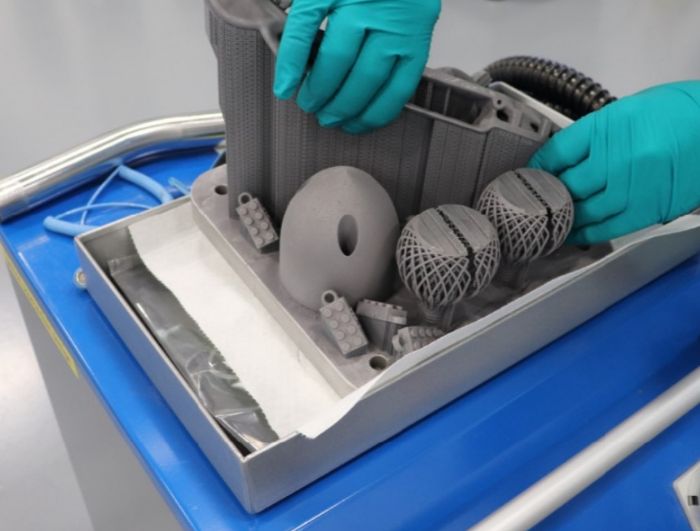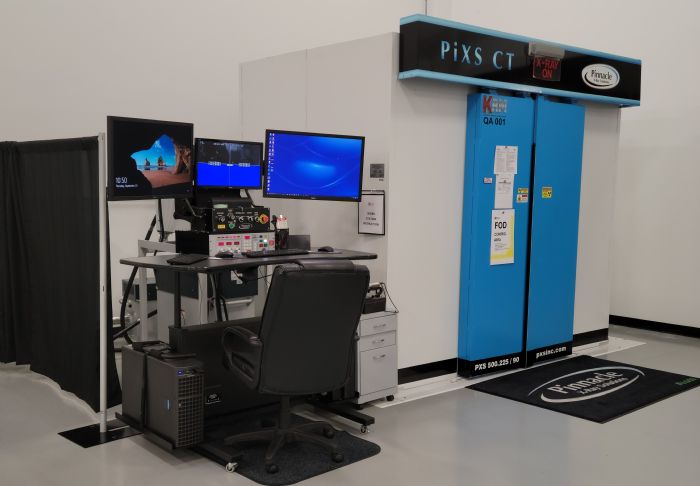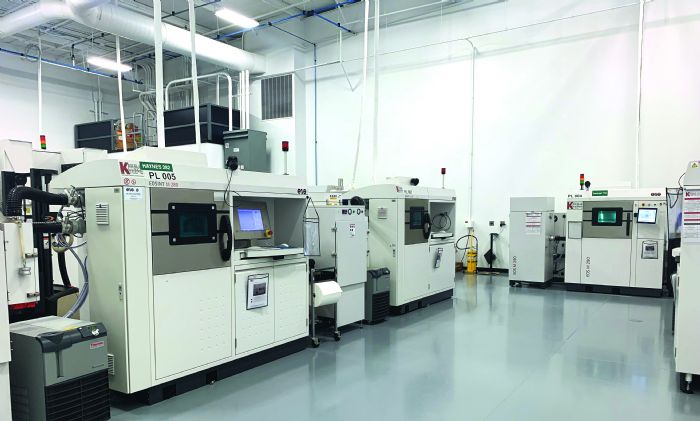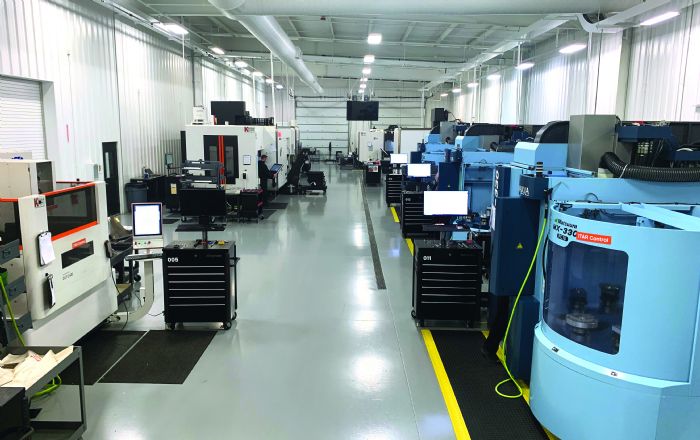Goal: Efficient Serialized Production
 With a loaded additive and subtractive equipment roster, the company has been laser-focused on teaming the two processes to efficiently provide serialized hybrid production, according to Carolyn Allan, AM marketing and customer relations manager at KAM.
With a loaded additive and subtractive equipment roster, the company has been laser-focused on teaming the two processes to efficiently provide serialized hybrid production, according to Carolyn Allan, AM marketing and customer relations manager at KAM.
“The additive and subtractive teams work in alignment from the beginning of each project to create the manufacturing plan,” Allan explains. “And, after development, we work on scaling serialized production. The additive and subtractive units work in lockstep to create a unified plan and produce the same part successfully and repeatedly. And, the electronic ERP system documents the entire process through each step of production—so there are no more paper routers.”
The teamwork and documentation become even more vital as production numbers increase for KAM, especially in its commercial-space and hypersonic-aerospace customer sectors, where part-run volumes number from 20 to 50 with serialized production taking hold.
KAM also machines additive cold plates, adding on thermal pads and shipping the finished assemblies to customers. In fact, the company has increasingly added assembly operations, and dedicates a room to assembly tasks.
 “Instead of outsourcing, we created an assembly team and added final assembly as an inhouse service,” says Allan. “This aligns with KAM’s value of offering customers a single-source delivery of complete products.”
“Instead of outsourcing, we created an assembly team and added final assembly as an inhouse service,” says Allan. “This aligns with KAM’s value of offering customers a single-source delivery of complete products.”
Meeting higher part volumes, delivering complete products as a single source and gearing for serialized production drove the recent equipment purchases detailed above, leaving little doubt that KAM can meet current customer order upticks as well as future orders.
“Positioning to meet current and future orders is always a balance because these markets can be volatile,” says Allan. “With our machine lineup in additive and subtractive, and our capabilities and expertise, we are agile enough to pivot and serve the hypersonic and commercial space sectors as needed with room to scale and take on larger projects.”
As for expertise, KAM can draw from the Carolinas manufacturing hot bed.
“Being Nascar country, there’s a lot of manufacturing talent available to us in the North Carolina technology hub,” Allan says.
That holds true especially in CNC machining, which has helped KAM solidify itself through subtractive capabilities.
“Inhouse machining represents a big differentiator for us,” Allan offers. “When outsourcing, many machine shops are afraid to take on machining of additive parts. But here, the teams work together to tackle any potential issues upfront. They talk together ahead of time—‘How can we fixture this?’ ‘How will the fixturing or the finished part look?’ ‘How can we design and print to ease the machining?’ The feedback between the teams makes the process work well.”
Besides coordinating on additive and subtractive processes to add efficiencies, KAM looks to gain other process efficiencies as well. For example, the company is exploring an AM alternative to brazing, a costly and time-consuming process that can yield discolored parts with relatively low-strength joints, among other disadvantages. Research at KAM examines traditionally brazed parts versus AM parts under a CT scanner—KAM offers a robust quality department, including CT scanning and in-process and offline quality checks.
“By examining these parts through CT scanning, we believe that we can achieve better parts through AM,” Allan says. “It can help our customers who are trying to overcome that brazing pain.”
Bringing Its Capabilities Mix to Bear
From the additions of ERP and cybersecurity software, production and inspection equipment, and talent to the meshing of additive and subtractive operations, KAM has the tools in place to tackle the challenges inherent in serialized production. And, importantly, it can tackle these challenges as a one-stop shop.
“We have so many certifications and qualifications required to become an approved supplier for the types of parts that we produce,” Keselowski tells 3D Metal Printing. “With that come the audits, conference calls, meetings, etc. And, an end user of a product of this type just doesn’t have enough time to do all of that with multiple vendors. A customer looking to buy a part needs that part to come to its door ready to go. If we must hand a part off and go back through that loop of paperwork and meetings and communication, misunderstandings will happen, and the project becomes a nightmare.
“Early on in KAM’s existence, we realized that a one-stop supplier is a point of significance to our customers,” he continues. “We had bought a ton of additive equipment, paused, and then bought a ton of subtractive equipment to become a one-stop shop. Usually, it goes the other way in this business—starting with subtractive equipment and adding some additive.”
Taking parts from design to AM to machining demands expertise and can be a risky maneuver—“Sure, we’ll print and ship you 20 parts, and then you can ship them to a machine shop that screws up 10 of them, and then we’ll print you some more,” Keselowski says, describing tongue-in-cheek how an AM-only house might profit.
“We take that risk, which is a benefit that KAM offers to our end-use customers,” he says. “We take the risk, and scrap parts, too. Any manufacturer will have scrap, and the additive parts that we produce are incredibly difficult to machine. Everything that makes them great for the end customer makes them incredibly awful to machine, whether it’s the difficulty of the materials or the complexity of the part. In fact, early on we had overflow work and tried to offload parts to other shops for machining. They wouldn’t touch them.”
KAM instead now relishes the idea of tackling difficult machining.
“Much of our success story to date is the ability to properly machine highly complex 3D-printed parts—complexity in design, complexity in materials, complexity across the board,” Keselowski says. “Our additive and subtractive teams are cross-functional—it’s our power-cell concept. The teams collaborate, which is important.”
This collaboration drives success at KAM, and positions it well as serialized production makes further inroads into AM.
“When we get a good serialized-production customer, we really have to put our full weight behind it, and then comes the transition period where we reload and go back hard,” Keselowski, channeling his competitive nature honed from years in top-level auto racing, concludes. “It’s like working out—it doesn’t feel all that good and you’re sore the next day, but you get stronger. We’re getting stronger.” 3DMP
Industry-Related Terms: Alloys,
CNC,
Die,
Draw,
Fixture,
Model,
NC,
Point,
Scale,
Scrap,
Stainless Steel,
SurfaceView Glossary of Metalforming Terms
See also: Mazak Corp., EOS of North America, Inc., SLM Solutions NA, Inc.
Technologies:
 Lou Kren
Lou Kren More than 2 yr. later, a 3DMP visit to KAM confirms that the company, with the motto “Aerospace Quality at Motorsport Speed,” has made tremendous progress toward that goal. KAM, having grown to 44 employees, combines engineering expertise with traditional and additive manufacturing (AM) capabilities and technology to serve customers in multiple sectors, led by aerospace and defense. The company also plays big in supplying heat exchangers and turbomachinery, with a bit of automotive mixed in. Nickel and aluminum alloys represent the bulk of material processed at KAM, along with some stainless steel, titanium and other alloys.
More than 2 yr. later, a 3DMP visit to KAM confirms that the company, with the motto “Aerospace Quality at Motorsport Speed,” has made tremendous progress toward that goal. KAM, having grown to 44 employees, combines engineering expertise with traditional and additive manufacturing (AM) capabilities and technology to serve customers in multiple sectors, led by aerospace and defense. The company also plays big in supplying heat exchangers and turbomachinery, with a bit of automotive mixed in. Nickel and aluminum alloys represent the bulk of material processed at KAM, along with some stainless steel, titanium and other alloys. In 2021 alone, KAM, as part of a focus on serialized production and growth, added $4.5 million in equipment to its 70,000-sq.-ft. operation, including multiple additive and subtractive machines, surface finishing equipment, and quality inspection equipment.
In 2021 alone, KAM, as part of a focus on serialized production and growth, added $4.5 million in equipment to its 70,000-sq.-ft. operation, including multiple additive and subtractive machines, surface finishing equipment, and quality inspection equipment.





 With a loaded additive and subtractive equipment roster, the company has been laser-focused on teaming the two processes to efficiently provide serialized hybrid production, according to Carolyn Allan, AM marketing and customer relations manager at KAM.
With a loaded additive and subtractive equipment roster, the company has been laser-focused on teaming the two processes to efficiently provide serialized hybrid production, according to Carolyn Allan, AM marketing and customer relations manager at KAM. “Instead of outsourcing, we created an assembly team and added final assembly as an inhouse service,” says Allan. “This aligns with KAM’s value of offering customers a single-source delivery of complete products.”
“Instead of outsourcing, we created an assembly team and added final assembly as an inhouse service,” says Allan. “This aligns with KAM’s value of offering customers a single-source delivery of complete products.”
